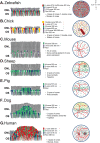Animal modelling for inherited central vision loss
- PMID: 26387748
- PMCID: PMC5063185
- DOI: 10.1002/path.4641
Animal modelling for inherited central vision loss
Abstract
Disease-causing variants of a large number of genes trigger inherited retinal degeneration leading to photoreceptor loss. Because cones are essential for daylight and central vision such as reading, mobility, and face recognition, this review focuses on a variety of animal models for cone diseases. The pertinence of using these models to reveal genotype/phenotype correlations and to evaluate new therapeutic strategies is discussed. Interestingly, several large animal models recapitulate human diseases and can serve as a strong base from which to study the biology of disease and to assess the scale-up of new therapies. Examples of innovative approaches will be presented such as lentiviral-based transgenesis in pigs and adeno-associated virus (AAV)-gene transfer into the monkey eye to investigate the neural circuitry plasticity of the visual system. The models reported herein permit the exploration of common mechanisms that exist between different species and the identification and highlighting of pathways that may be specific to primates, including humans.
Keywords: blindness; cones; fovea; macula; retinal degeneration.
© 2015 The Authors. The Journal of Pathology published by John Wiley & Sons Ltd on behalf of Pathological Society of Great Britain and Ireland.
Figures

References
-
- Hood DC, Finkelstein MA. Sensory processes and perception In Handbook of Perception and Human Performance, Boff KR, Kaufman L, Thomas JP. (eds). John Wiley: Toronto, 1986; 1 : 5‐1–5‐66.
-
- Roosing S, Thiadens AA, Hoyng CB, et al. Causes and consequences of inherited cone disorders. Prog Retin Eye Res 2014; 42: 1–26. - PubMed
-
- Slijkerman RW, Song F, Astuti GD, et al. The pros and cons of vertebrate animal models for functional and therapeutic research on inherited retinal dystrophies. Prog Retin Eye Res 2015; 48 : 137–159. - PubMed
Publication types
MeSH terms
LinkOut - more resources
Full Text Sources
Other Literature Sources
Molecular Biology Databases

